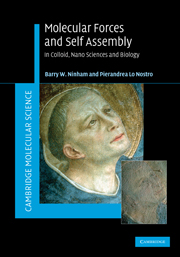Preface
Published online by Cambridge University Press: 06 January 2011
Summary
This book outlines developments in physical and colloid chemistry over the last decade or two that have changed our understanding of molecular forces and the self assembly of amphiphilic molecules. Within the sciences, a subject or discipline is defined by a freemasonry, the members of which are united by a common lore. The received beliefs of adepts are reaffirmed by recitation and repetition of the lore, and reinforced by the weight of authority embodied in the literature of the discipline. The more venerable the literature, the more conservative is the freemasonry. Challengers to the canon are at first dismissed as heretics or apostates, but if, later, their claims are conceded to have validity, they and their theories are eventually accepted into the fold. The discipline moves on. So, the advocates of a once revolutionary Darwinism, wrongly defined by others by the trite aphorism ‘survival of the fittest’, retreated into convoluted defences of the dogma, represented by the elegant writings of Stephen J. Gould. Two decades ago the notion that environmental influences such as temperature could affect gene expression invited the ridicule attending to an earlier Lamarkism. Similarly for any questioning of the dogma of the Weissman barrier in immunology. Not any more.
The origins of the discipline of modern physical chemistry can probably be dated most conveniently to Napoleon's scientific expedition to Egypt 200 years ago. Berthelot, one of the expedition's scientists, observed on the receding flood plain of the Nile rocks that were covered with soda lime, sodium carbonate.
- Type
- Chapter
- Information
- Molecular Forces and Self AssemblyIn Colloid, Nano Sciences and Biology, pp. xi - xviPublisher: Cambridge University PressPrint publication year: 2010



